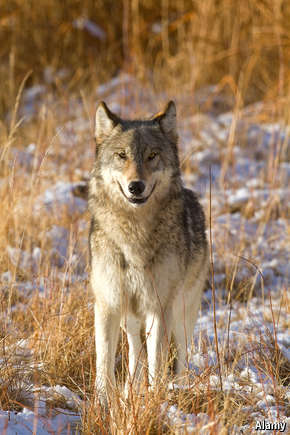Don’t let the grey hair fool you
Wolves were driven to extinction by hunting in the Yellowstone region in the early 20th century, but were reintroduced in 1995 and have been closely monitored ever since by the National Park Service. This includes tranquillising 25 or so wolves a year and fitting them with radio collars so they can be tracked. Among the wealth of information this effort has produced, in 2007 researchers were alerted to a contagious illness creeping into the population.
Known as mange, the disease is caused by parasitic mites that burrow into the flesh of wolves, causing an extreme allergic reaction and driving them to scratch to the point of losing large amounts of their fur. Left untreated, the mites weaken the animals they infect, making them vulnerable to starvation and more diseases.
The researchers, led by Emily Almberg of Pennsylvania State University, expected to see mange appear with greater frequency in large wolf packs rather than small ones. The larger packs, after all, had more wolves roving across the landscape, and thus a greater chance of one of their number coming into contact with the mites and spreading the disease to the others. But that is not what the researchers found.
Wolves living in large packs were no more likely to become infected by the mites than those in small packs or living on their own, the team report in Ecology Letters. Why this is so remains to be determined, but Dr Almberg suspects that it has something to do with territorial behaviour. The wolves avoid contact with other packs which, in turn, limits opportunities for disease transmission.
More intriguing, though, was the discovery that wolves living in a large group were better at fending off the disease. Wolves living in packs were five times less likely to die from mange than wolves that caught it whilst living on their own. “We saw wolves missing hair on over half of their bodies in the middle of winter surviving the season just as well as uninfected wolves, so long as they were living in a large group,” says Dr Almberg. She thinks this is due to other wolves being available to help the ill ones find and catch food.
When it comes to fighting for territory, another study has found the composition of the pack matters as well as its size. A team of ecologists led by Kira Cassidy of the University of Minnesota report in Behavioral Ecology that in an analysis of 121 conflicts between Yellowstone wolves, larger packs (with an average of 9.4 wolves) were, as might be expected, more likely to win over a small pack (5.8 wolves). Nevertheless, two factors could change the outcome considerably.
The first was that males matter. Wolf packs with a greater proportion of adult males, even if the pack itself was smaller than those they took on, stood a good chance of defeating their rivals. Statistically, Ms Cassidy was able to work out that having one more adult male than a rival pack of a similar size increased the chances of victory by 65%.
The second finding was that the presence of a wolf (of any gender) that was aged six or older has a bigger impact on the odds of victory than a straightforward numerical advantage. Ms Cassidy found that in a fight between two packs without any of these older wolves, one with five members and the other six, the larger group would be 140% more likely to win. If two packs of equal size went head-to-head, the presence of an older animal in one group would increase the chance of that pack winning by a very useful 150%.
As the average lifespan of a wolf in Yellowstone is four years, once infant mortality is excluded, the old wolves that appear to tip the balance during battles are at least two years past their prime. It seems unlikely that they lend brawn to the fight as much as some sort of experience. Whether that is by imparting improved combat tactics to their packmates or because they are more effective fighters due to years of practice is unclear. There are more lessons to be learned from Yellowstone’s wolves.
From the print edition of The Economist



No comments:
Post a Comment